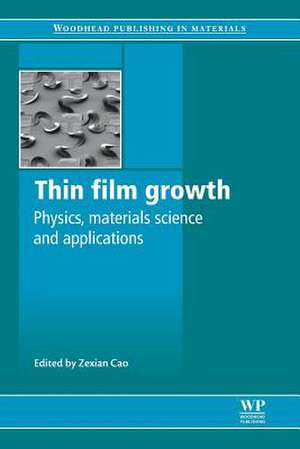Thin Film Growth: Physics, Materials Science and Applications: Woodhead Publishing Series in Electronic and Optical Materials
Editat de Zexian Caoen Limba Engleză Paperback – 18 aug 2016
Part one focuses on the theory of thin film growth, with chapters covering nucleation and growth processes in thin films, phase-field modelling of thin film growth and surface roughness evolution. Part two covers some of the techniques used for thin film growth, including oblique angle deposition, reactive magnetron sputtering and epitaxial growth of graphene films on single crystal metal surfaces. This section also includes chapters on the properties of thin films, covering topics such as substrate plasticity and buckling of thin films, polarity control, nanostructure growth dynamics and network behaviour in thin films.
With its distinguished editor and international team of contributors, Thin film growth is an essential reference for engineers in electronics, energy materials and mechanical engineering, as well as those with an academic research interest in the topic.
- Provides an important and up-to-date review of the theory and deposition techniques used in the formation of thin films
- Focusses on the theory and modelling of thin film growth, techniques and mechanisms used for thin film growth and properties of thin films
- An essential reference for engineers in electronics, energy materials and mechanical engineering
Din seria Woodhead Publishing Series in Electronic and Optical Materials
- 18%
 Preț: 2155.45 lei
Preț: 2155.45 lei - 24%
 Preț: 1160.66 lei
Preț: 1160.66 lei - 39%
 Preț: 1136.44 lei
Preț: 1136.44 lei - 9%
 Preț: 912.54 lei
Preț: 912.54 lei - 9%
 Preț: 956.68 lei
Preț: 956.68 lei - 24%
 Preț: 951.04 lei
Preț: 951.04 lei - 9%
 Preț: 1335.64 lei
Preț: 1335.64 lei - 29%
 Preț: 986.78 lei
Preț: 986.78 lei - 24%
 Preț: 874.56 lei
Preț: 874.56 lei - 29%
 Preț: 1075.95 lei
Preț: 1075.95 lei - 29%
 Preț: 1414.77 lei
Preț: 1414.77 lei - 9%
 Preț: 1216.61 lei
Preț: 1216.61 lei - 39%
 Preț: 811.62 lei
Preț: 811.62 lei - 29%
 Preț: 1193.77 lei
Preț: 1193.77 lei - 9%
 Preț: 1444.32 lei
Preț: 1444.32 lei - 24%
 Preț: 926.89 lei
Preț: 926.89 lei - 9%
 Preț: 1107.16 lei
Preț: 1107.16 lei - 9%
 Preț: 1262.45 lei
Preț: 1262.45 lei - 9%
 Preț: 954.69 lei
Preț: 954.69 lei - 9%
 Preț: 1006.73 lei
Preț: 1006.73 lei - 9%
 Preț: 958.65 lei
Preț: 958.65 lei - 9%
 Preț: 948.72 lei
Preț: 948.72 lei - 9%
 Preț: 1150.61 lei
Preț: 1150.61 lei - 23%
 Preț: 1493.72 lei
Preț: 1493.72 lei - 9%
 Preț: 950.94 lei
Preț: 950.94 lei - 24%
 Preț: 1276.29 lei
Preț: 1276.29 lei - 29%
 Preț: 1333.73 lei
Preț: 1333.73 lei - 9%
 Preț: 1130.18 lei
Preț: 1130.18 lei - 9%
 Preț: 1049.49 lei
Preț: 1049.49 lei - 24%
 Preț: 871.12 lei
Preț: 871.12 lei - 27%
 Preț: 1459.23 lei
Preț: 1459.23 lei - 20%
 Preț: 1071.49 lei
Preț: 1071.49 lei - 24%
 Preț: 932.11 lei
Preț: 932.11 lei - 29%
 Preț: 1071.64 lei
Preț: 1071.64 lei - 24%
 Preț: 670.36 lei
Preț: 670.36 lei - 9%
 Preț: 926.48 lei
Preț: 926.48 lei - 23%
 Preț: 929.43 lei
Preț: 929.43 lei - 9%
 Preț: 897.50 lei
Preț: 897.50 lei - 9%
 Preț: 1276.81 lei
Preț: 1276.81 lei - 9%
 Preț: 957.63 lei
Preț: 957.63 lei - 29%
 Preț: 845.10 lei
Preț: 845.10 lei - 9%
 Preț: 953.05 lei
Preț: 953.05 lei - 33%
 Preț: 1126.67 lei
Preț: 1126.67 lei - 29%
 Preț: 954.77 lei
Preț: 954.77 lei - 24%
 Preț: 961.16 lei
Preț: 961.16 lei - 23%
 Preț: 930.29 lei
Preț: 930.29 lei - 23%
 Preț: 1080.19 lei
Preț: 1080.19 lei
Preț: 901.22 lei
Preț vechi: 990.35 lei
-9% Nou
Puncte Express: 1352
Preț estimativ în valută:
172.44€ • 180.05$ • 142.72£
172.44€ • 180.05$ • 142.72£
Carte tipărită la comandă
Livrare economică 28 martie-11 aprilie
Preluare comenzi: 021 569.72.76
Specificații
ISBN-13: 9780081017227
ISBN-10: 0081017227
Pagini: 432
Dimensiuni: 156 x 234 x 22 mm
Greutate: 0.6 kg
Editura: ELSEVIER SCIENCE
Seria Woodhead Publishing Series in Electronic and Optical Materials
ISBN-10: 0081017227
Pagini: 432
Dimensiuni: 156 x 234 x 22 mm
Greutate: 0.6 kg
Editura: ELSEVIER SCIENCE
Seria Woodhead Publishing Series in Electronic and Optical Materials
Cuprins
Contributor contact details
Praface
Part I: Theory of thin film growth
Chapter 1: Measuring nucleation and growth processes in thin films
Abstract:
1.1 Introduction
1.2 Basic theory of epitaxial growth
1.3 Observation method of atomic steps
1.4 Two-dimensional-island nucleation and step-flow growth modes
1.5 The motion of atomic steps on a growing and evaporating Si(111) surface
1.6 Morphological instability of atomic steps
1.7 Conclusion and future trends
1.9 Appendix
Chapter 2: Quantum electronic stability of atomically uniform films
Abstract:
2.1 Introduction
2.2 Electronic growth
2.3 Angle-resolved photoemission spectroscopy
2.4 Atomically uniform films
2.5 Quantum thermal stability of thin films
2.6 General principles of film stability and nanostructure development
2.7 Beyond the particle-in-a-box
2.8 Future trends
2.9 Acknowledgments
Chapter 3: Phase-field modeling of thin film growth
Abstract:
3.1 Introduction
3.2 Modeling
3.3 Numerical results
3.4 Conclusion
Chapter 4: Analysing surface roughness evolution in thin films
Abstract:
4.1 Introduction
4.2 Roughness during homo-epitaxial growth
4.3 Roughness during hetero- or non-epitaxial growth
4.4 Future trends
Chapter 5: Modelling thin film deposition processes based on real-time observation
Abstract:
5.1 Introduction: time resolved surface science
5.2 Basics of growth and relevant length of and timescales for in-situ observation of film deposition
5.3 Experimental techniques for real-time and in-situ studies
5.4 Experimental case studies
5.5 Future trends
5.6 Sources of further information and advice
Part II: Techniques of thin film growth
Chapter 6: Silicon nanostructured films grown on templated surfaces by oblique angle deposition
Abstract:
6.1 Introduction
6.2 Preparation of templated surface for oblique angle deposition
6.3 Fan-out on templated surface with normal incident flux
6.4 Fan-out growth on templated surfaces with oblique angle incident flux
6.5 Control of fan-out growth with substrate rotations
6.6 Applications and future trends
Chapter 7: Phase transitions in colloidal crystal thin films
Abstract:
7.1 Introduction
7.2 Experimental tools
7.3 Description of colloidal crystal phases: historical survey
7.4 Phase transition sequence in colloidal crystal thin films
7.5 Conclusions and future trends
7.6 Acknowledgements
Chapter 8: Thin film growth for thermally unstable noble-metal nitrides by reactive magnetron sputtering
Abstract:
8.1 Introduction
8.2 Deposition of stoichiometric Cu3N
8.3 Nitrogen re-emission
8.4 Doping of Cu3N by co-sputtering
8.5 Conclusions
Chapter 9: Growth of graphene layers for thin films
Abstract:
9.1 Introduction
9.2 Large-scale pattern growth of graphene films for stretchable transparent electrodes
9.3 Roll-to-roll production of 30-inch graphene films for transparent electrodes
9.4 Conclusions
Chapter 10: Epitaxial growth of graphene thin films on single crystal metal surfaces
Abstract:
10.1 Introduction
10.2 Structure of graphene on metals
10.3 Growth of graphene on a metal
10.4 Future trends
10.5 Sources of further information and advice
10.6 Acknowledgements
Chapter 11: Electronic properties and adsorption behaviour of thin films with polar character
Abstract:
11.1 Introduction to oxide polarity
11.2 Polar oxide films
11.3 Measuring polarity of thin oxide films
11.4 Adsorption properties of polar films
11.5 Conclusion and future trends
11.7 Acknowledgements
11.6 Sources of further information and advice
Chapter 12: Polarity controlled epitaxy of III-nitrides and ZnO by molecular beam epitaxy
Abstract:
12.1 Introduction
12.2 Lattice polarity and detection methods
12.3 Polarity issues at heteroepitaxy and homoepitaxy
12.4 Polarity controlled epitaxy of GaN and AlN
12.5 Polarity controlled epitaxy of InN
12.6 Polarity controlled epitaxy of ZnO
12.7 Conclusions
Chapter 13: Understanding substrate plasticity and buckling of thin films
Abstract:
13.1 Introduction
13.2 Experimental observations
13.3 Modelling
13.4 Discussion
13.5 Conclusions
Chapter 14: Controlled buckling of thin films on compliant substrates for stretchable electronics
Abstract:
14.1 Introduction
14.2 Mechanics of one-dimensional non-coplanar mesh design
14.3 Mechanics of two-dimensional non-coplanar mesh design
14.4 Conclusions
Chapter 15: The electrocaloric effect (ECE) in ferroelectric polymer films
Abstract:
15.1 Introduction
15.2 Thermodynamic considerations on materials with large electrocaloric effect (ECE)
15.3 Previous investigations on electrocaloric effect (ECE) in polar materials
15.4 Large electrocaloric effect (ECE) in ferroelectric polymer films
15.5 Future trends
15.6 Conclusion
15.7 Acknowledgements
Chapter 16: Network behavior in thin films and nanostructure growth dynamics
Abstract:
16.1 Introduction
16.2 Origins of network behavior during thin film growth
16.3 Monte Carlo simulations
16.4 Results and discussion
16.5 Conclusions
Index
Praface
Part I: Theory of thin film growth
Chapter 1: Measuring nucleation and growth processes in thin films
Abstract:
1.1 Introduction
1.2 Basic theory of epitaxial growth
1.3 Observation method of atomic steps
1.4 Two-dimensional-island nucleation and step-flow growth modes
1.5 The motion of atomic steps on a growing and evaporating Si(111) surface
1.6 Morphological instability of atomic steps
1.7 Conclusion and future trends
1.9 Appendix
Chapter 2: Quantum electronic stability of atomically uniform films
Abstract:
2.1 Introduction
2.2 Electronic growth
2.3 Angle-resolved photoemission spectroscopy
2.4 Atomically uniform films
2.5 Quantum thermal stability of thin films
2.6 General principles of film stability and nanostructure development
2.7 Beyond the particle-in-a-box
2.8 Future trends
2.9 Acknowledgments
Chapter 3: Phase-field modeling of thin film growth
Abstract:
3.1 Introduction
3.2 Modeling
3.3 Numerical results
3.4 Conclusion
Chapter 4: Analysing surface roughness evolution in thin films
Abstract:
4.1 Introduction
4.2 Roughness during homo-epitaxial growth
4.3 Roughness during hetero- or non-epitaxial growth
4.4 Future trends
Chapter 5: Modelling thin film deposition processes based on real-time observation
Abstract:
5.1 Introduction: time resolved surface science
5.2 Basics of growth and relevant length of and timescales for in-situ observation of film deposition
5.3 Experimental techniques for real-time and in-situ studies
5.4 Experimental case studies
5.5 Future trends
5.6 Sources of further information and advice
Part II: Techniques of thin film growth
Chapter 6: Silicon nanostructured films grown on templated surfaces by oblique angle deposition
Abstract:
6.1 Introduction
6.2 Preparation of templated surface for oblique angle deposition
6.3 Fan-out on templated surface with normal incident flux
6.4 Fan-out growth on templated surfaces with oblique angle incident flux
6.5 Control of fan-out growth with substrate rotations
6.6 Applications and future trends
Chapter 7: Phase transitions in colloidal crystal thin films
Abstract:
7.1 Introduction
7.2 Experimental tools
7.3 Description of colloidal crystal phases: historical survey
7.4 Phase transition sequence in colloidal crystal thin films
7.5 Conclusions and future trends
7.6 Acknowledgements
Chapter 8: Thin film growth for thermally unstable noble-metal nitrides by reactive magnetron sputtering
Abstract:
8.1 Introduction
8.2 Deposition of stoichiometric Cu3N
8.3 Nitrogen re-emission
8.4 Doping of Cu3N by co-sputtering
8.5 Conclusions
Chapter 9: Growth of graphene layers for thin films
Abstract:
9.1 Introduction
9.2 Large-scale pattern growth of graphene films for stretchable transparent electrodes
9.3 Roll-to-roll production of 30-inch graphene films for transparent electrodes
9.4 Conclusions
Chapter 10: Epitaxial growth of graphene thin films on single crystal metal surfaces
Abstract:
10.1 Introduction
10.2 Structure of graphene on metals
10.3 Growth of graphene on a metal
10.4 Future trends
10.5 Sources of further information and advice
10.6 Acknowledgements
Chapter 11: Electronic properties and adsorption behaviour of thin films with polar character
Abstract:
11.1 Introduction to oxide polarity
11.2 Polar oxide films
11.3 Measuring polarity of thin oxide films
11.4 Adsorption properties of polar films
11.5 Conclusion and future trends
11.7 Acknowledgements
11.6 Sources of further information and advice
Chapter 12: Polarity controlled epitaxy of III-nitrides and ZnO by molecular beam epitaxy
Abstract:
12.1 Introduction
12.2 Lattice polarity and detection methods
12.3 Polarity issues at heteroepitaxy and homoepitaxy
12.4 Polarity controlled epitaxy of GaN and AlN
12.5 Polarity controlled epitaxy of InN
12.6 Polarity controlled epitaxy of ZnO
12.7 Conclusions
Chapter 13: Understanding substrate plasticity and buckling of thin films
Abstract:
13.1 Introduction
13.2 Experimental observations
13.3 Modelling
13.4 Discussion
13.5 Conclusions
Chapter 14: Controlled buckling of thin films on compliant substrates for stretchable electronics
Abstract:
14.1 Introduction
14.2 Mechanics of one-dimensional non-coplanar mesh design
14.3 Mechanics of two-dimensional non-coplanar mesh design
14.4 Conclusions
Chapter 15: The electrocaloric effect (ECE) in ferroelectric polymer films
Abstract:
15.1 Introduction
15.2 Thermodynamic considerations on materials with large electrocaloric effect (ECE)
15.3 Previous investigations on electrocaloric effect (ECE) in polar materials
15.4 Large electrocaloric effect (ECE) in ferroelectric polymer films
15.5 Future trends
15.6 Conclusion
15.7 Acknowledgements
Chapter 16: Network behavior in thin films and nanostructure growth dynamics
Abstract:
16.1 Introduction
16.2 Origins of network behavior during thin film growth
16.3 Monte Carlo simulations
16.4 Results and discussion
16.5 Conclusions
Index








